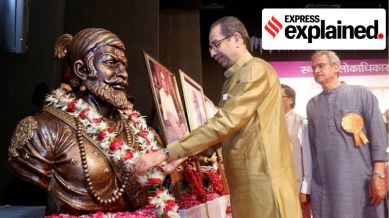The role of Marathi in the political dynamics of Mumbai and Maharashtra
Marathi is the foremost linguistic and cultural symbol of Maharashtra, a core identifier for its people, and an object of great regional pride. From the Samyukta Maharashtra Movement to now, it has played a central role in the politics of the state and its capital

Senior RSS leader Suresh ‘Bhaiyyaji’ Joshi’s statements that “Mumbai does not have one language” and “people coming to Mumbai do not have to learn Marathi”, have ignited a political firestorm and given the opposition Maha Vikas Aghadi (MVA) ammunition to target the BJP.
What role does Marathi play in the political dynamics of Mumbai and Maharashtra, and how has the language been used as a political symbol over the decades?
monthly limit of free stories.
with an Express account.
What is the significance of Marathi beyond being the language spoken by the largest number of people in Maharashtra?
Marathi is the linguistic and cultural symbol of Maharashtra, the core identity of its people, and an object of their great pride and self-respect.
It has a strong resonance and powerful political significance in Mumbai and for Mumbaikars, Maharashtrians who have historically lived in the city, and speak the Marathi language.
Over the decades, politics in Mumbai has been shaped by efforts to preserve and promote the Marathi language and culture. It has played a central role in political movements in the city, especially as its original identity underwent changes with the arrival of migrants from other parts of India.
Which political movements were centred around the Marathi language and identity in Mumbai?
- 01
Samyukta Maharashtra Movement
The Samyukta Maharashtra Movement of the 1950s fought for the creation of a separate Marathi-speaking state of Maharashtra, arguing that it was necessary to preserve their cultural and linguistic identity.
- 02
Shiv Sena
While the Samyukta Maharashtra Movement was instrumental in the birth of the state, Bal Thackeray’s Shiv Sena, founded in 1966, became the most influential political force advocating the interests of Marathi-speaking people in Mumbai.
Marathi nationalism lay at the heart of the Shiv Sena’s ideology, and it militated for prioritising Marathi speakers in employment, housing, and political representation, especially in the face of growing migration of non-Maharashtrians into Mumbai.
- 03
Maharashtra Navnirman Sena
The third and most recent major political movement rooted in Marathi subnationalism was launched by Raj Thackeray’s Maharashtra Navnirman Sena. The MNS focused on migration, especially the overrepresentation of non-Marathi speakers in Mumbai’s economy.
While the MNS has been criticised often for its aggressive stance towards North Indians, the party has also targeted the hold of Gujarati communities on Mumbai’s business and political circles.
Is the number of Marathi speakers declining in Mumbai?
There are no comprehensive recent data on the linguistic profile of Mumbai. In the 2011 Census, the number of people identifying Hindi as their mother tongue increased by about 40% to 35.98 lakh from 25.88 lakh in the previous Census.
Marathi speakers, despite being the largest ethnolinguistic group in the city, declined from 45.24 lakh in 2001 to 44.04 lakh in 2011.
Gujarati speakers also saw a slight decline from 14.34 lakh to 14.28 lakh. Urdu speakers experienced a sharp 8% decline, dropping from 16.87 lakh to 14.59 lakh.
What accounts for the decline in the number of Marathi speakers and increase in the number of Hindi speakers in Mumbai?
Over the past four decades, Mumbai has undergone a shift from being an industrial city to a service-oriented one, which has also changed its migration patterns.
Inter-state migration from places like Uttar Pradesh and Bihar has increased in line with the demand for cheap labour in the expanding service sector.
However, the sharp increase in the numbers of Hindi speakers between the 2001 and 2011 censuses could be the result of underreporting in previous census data.
The growing housing constraints within the city have driven many Marathi-speaking residents away from the heart of Mumbai to its peripheral regions, such as Thane and Palghar districts.
Has the decreasing share of Marathi speakers in Mumbai affected their political power?
In the 1970s, almost 60% of elected representatives from Mumbai in the Assembly were non-Marathi speakers. This situation has changed since then.
The percentage of Marathi-speaking MLAs from Mumbai has increased steadily, peaking at 69% in 2019 before dropping to 64% in the most recent election.
The BJP’s sweeping electoral successes over the past decade has triggered anxieties in some parts of the country where local people perceive a threat to their linguistic and cultural identities from an overarching Hindi-Hindu nationalism. The BJPs push for a single Bharatiya identity is often seen as an effort to undermine regional autonomies. In Maharashtra too, many Marathi speakers fear a possible marginalisation of their linguistic identity in the face of Hindi’s dominance.